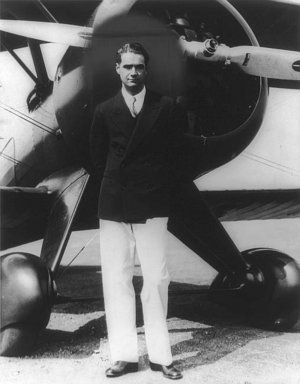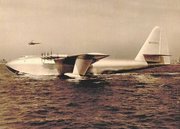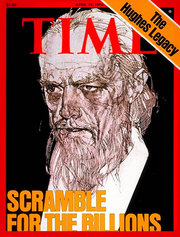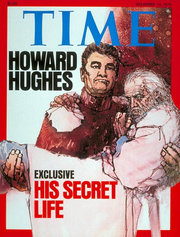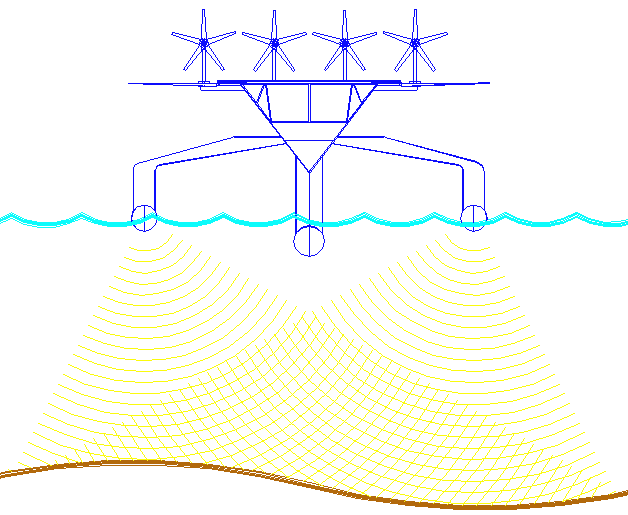|
HOWARD HUGHES 1905-1976
|
|||
|
Best known as: aviator, movie producer, billionaire, hypochondriac.
Born: Howard Robard Hughes (December 24, 1905 – April 5, 1976) was at times a pilot, a movie producer, a playboy, an eccentric and one of the wealthiest people in the world. His well-known eccentricity is believed to have been the result of bipolar disorder or obsessive-compulsive disorder.
Howard Hughes and Boeing Army pursuit plane - California 1940s
Youth and Hollywood
Howard Hughes was born in Texas. Various sources cite both Humble and Houston as his birthplace. His parents were Alene (Gano) Hughes and Howard R. Hughes, Sr., who invented the dual cone roller bit for the rotary drilling of oil wells in previously inaccessible oil formations. His father founded Hughes Tool Company to commercialize this invention.
Family
Mother: Allene (Gano) Hughes (died March 29, 1922); Father: Howard Robard Hughes, Sr., founder of Hughes Tool Company (died January 14, 1924); Uncle: father's brother Rupert, a writer for Samuel Goldwyn's movie studios; Wives: Houston socialite Ella Rice (married June 1, 1925, divorced in 1929); Actress Jean Peters (married 1957, divorced 1970); Hughes often dated Hollywood actresses in the 1930s, especially Katherine Hepburn.
Education
Hughes attended private school in Boston, where he was better at golf than classwork. He was attending Thacher School in California when his mother died. In California, Hughes spent time with his uncle, Rupert, who inspired his later interest in filmmaking. Hughes never graduated from high school. Nonetheless, his father arranged for him to sit in on classes at Cal Tech by donating money to the school. Afterward, Howard returned to Houston and enrolled at Rice Institute (now Rice University). Howard, Sr. died suddenly a few weeks after his son turned eighteen. Young Howard inherited much of the family estate and dropped out of Rice.
As a teenager, Hughes declared that his goals in life were to become the world's best golfer, the world's best pilot, and the world's best movie producer. Despite attending many good schools, he never earned a diploma. He attended the Fessenden School in West Newton, Massachusetts (near Boston), and the Thacher School in Ojai, California. His father subsequently arranged for him to audit math and engineering classes at the California Institute of Technology. He then enrolled at the Rice Institute (later known as Rice University).
His parents died when he was a teenager. His mother died in 1922, and his father two years later, allowing him to inherit the highly profitable Hughes Tool Company. After inheriting $17 million, Hughes dropped out of Rice to become CEO of Hughes Tool in 1924 at the age of 19.
Family business
Uncle Rupert supervised Howard's part of the estate and interests in the Hughes Tool Company until he was twenty-one. Family quarrels led Howard to have company lawyers buy out his relatives. A Houston judge and friend of his late father's granted Howard legal adulthood on December 26, 1924, allowing him to take over the tool company.
Shortly after his father died, Hughes moved to Hollywood, California where he had an uncle, Rupert Hughes, who was also a novelist. Ella Rice, a girlfriend whom he had met in Houston, joined him in California. They married in 1925 (and would divorce in 1929).
Career
Movies: Following the summer of 1924, Howard and Ella moved to Hollywood to pursue Howard's interest in making movies. When his first attempt failed, he hired Noah Dietrich to head the movie subsidiary of his tool company, and Lewis Mileston as director. The new team won an academy award for Two Arabian Nights (1928).
Their next film, Hell's Angels (1930), written and directed by Hughes and starring Jean Harlow, was the most expensive movie of its time at a cost of $3.8 million. This movie, about World War I aviators, lost $1.5 million at the box office but allowed Hughes to indulge his interest in flying. While shooting Hell's Angels, Hughes earned his pilot's license. Two later Hughes films tested the limits of public morality. Scarface (1932) was censored until Hughes sued to allow its release, and The Outlaw (1941) became controversial for its sexually explicit advertising and content, both featuring a sensational décolletage worn by a busty Jane Russell.
Inspired by the excitement over The Outlaw, Hughes later took a break from airplane fuselage design to create the half-cup bra, modelled of course by his Hollywood discovery, Jane Russell. It was in the '30s that Hughes built the Texas Theater, the movie house in the Oak Cliff section of Dallas in which Lee Harvey Oswald was arrested in 1963. The closeness of both men to the CIA makes it all but certain that the Texas Theater would have become a clandestine meeting place for spies. Such use of movie theaters had long been a staple of espionage tradecraft, and other Hughes properties were put to similar use. Hughes owned the RKO movie studio from 1948 to 1955.
Hughes used his fortune to become a movie producer. He was at first laughed off by Hollywood insiders as a rich man's son. However, his first two films released in 1927, Everybody's Acting and Two Arabian Knights were financial successes. His films The Racket in 1928 and The Front Page in 1931 were nominated for Academy Awards. Other movies included one of the world's first multi-million dollar productions Hell's Angels (1930) which was written and directed by Hughes and showcased his love for aviation, and Scarface (1932). His best-known film may be The Outlaw (1943) starring Jane Russell. Both Scarface and The Outlaw received attention from the industry censors, who targeted the films for their disregard of certain moral standards set forth within the industry.
During this time, Hughes wooed many of Hollywood's most famous actresses, including Katharine Hepburn, Bette Davis, Gene Tierney, Jean Harlow and Ava Gardner.
XF-11 prototype
Hughes the aviator and engineer
Aviation: In 1932, Hughes formed the Hughes Aircraft Company division of Hughes Tool. The company has pioneered many innovations in aerospace technology. But its origin was an attempt to finance the expensive conversion of a military plane into a racing plane. The next year, he achieved a false status by lobbying the Commerce Department to lower his pilot's license number from 4223 to 80. Charles Lindbergh's number was 69. The only real job Hughes ever had also came in 1933. He signed on as a co-pilot for American Airways. He applied under the name Charles W. Howard. The ruse was quickly discovered, however, and Hughes resigned. After entering and winning the 1934 All-America Air Meet in Miami, Hughes built and personally test-piloted the world's most advanced plane, the H-1. On September 13, 1935, he set a new speed record, taking the plane to 352 mph.
Over the next two years, he set two new records with transcontinental flights. Between July 10 and 14, 1938, Hughes piloted a special Lockheed 14 with a crew of four on a flight around the world. He cut Lindbergh's New York to Paris record in half, and finished the trip in three days, nineteen hours and seventeen minutes. Houston's airport was renamed in his honor. As World War II approached, Hughes turned his full attention to building military aircraft. But his regard for secrecy and disregard for military protocol and standardized materials kept him from getting contracts. Henry J. Kaiser, the famous shipbuilder, helped Hughes get a contract to build three "flying boats" for $18 million in three months. Those terms proved impossible for Hughes. In the end, he produced only one of the planes after the war ended. It was flown only once on November 2, 1947, by Hughes himself.
The public ridiculed him by calling the plane "The Spruce Goose." Another wartime contract for reconnaissance planes went similarly unfulfilled, and caused the deaths of two people when Hughes crashed during a test flight at Lake Mead. In 1947, the Senate investigated Hughes failure to meet his wartime contracts. In the 1950s and beyond, Hughes manufactured spy satellites.
Hughes was a lifelong aircraft enthusiast, pilot, and self-taught aircraft engineer. He set many world records, and designed and built several aircraft himself while heading Hughes Aircraft. On January 19, 1937 Hughes set a new air record by flying from Los Angeles to New York City in 7 hours, 28 minutes and 25 seconds. Then on July 10, 1938 he set another new record by completing a 91-hour airplane flight around the world. In 1938, the William P. Hobby Airport in Houston, Texas, known at the time as Houston Municipal Airport, was re-named "Howard Hughes Airport," but the name was changed back after people objected to naming the airport after a living person. As an aviator, he received many awards. This included the Harmon Trophy in 1936 and 1938, the Collier Trophy in 1939, the Octave Chanute Award in 1940, and a special Congressional medal for his round-the-world flight.
Also in 1938, William John Frye, a former Hollywood stunt flier and Trans World Airlines' (TWA) first director of operations, put in an order for the new 33-passenger Boeing 307 Stratoliner, the first commercial plane with a pressurized passenger cabin. He convinced Hughes, also enamored of avant garde aircraft technology, to finance this purchase. By doing so, Hughes became the principal stockholder of TWA in April 1939. Throughout the 1940s and into the 1950s, TWA continued to bet on the most advanced planes available, largely due to Hughes' own interest in aircraft development. The airline would grow significantly under his leadership.
H4 Hercules - the Spruce Goose
On July 7, 1946, Hughes barely survived a plane crash. He was piloting the maiden flight of the experimental aircraft XF-11, an Army spy plane. His flight plan included a tour of Los Angeles to show off the new plane, but an oil leak caused one of the counter-rotating propellers to reverse direction. Hughes tried to save the craft by landing it on the Los Angeles Country Club golf course, but seconds before he reached his attempted destination the plane started dropping dramatically and the aircraft crashed (http://www.check-six.com/Crash_Sites/XF-11_crash_site.htm) into the Beverly Hills neighborhood surrounding the Country Club. When the plane finally stopped after clipping three houses, the fuel tanks exploded, setting fire to a home and the surrounding area.
Hughes lay wounded beside the burning airplane until he was rescued by a Marine master sergeant who was visiting friends next door. The injuries he sustained in the crash, including a crushed collar bone, six broken ribs and third-degree burns, affected him until his death. Many attribute his long addiction to opiates to the large amounts of morphine he was prescribed for the injuries. The trademark mustache he wore later in life was an attempt to cover a minor facial scar from the incident.
One of his greatest endeavors was the H-4 Hercules, nicknamed the Spruce Goose, a massive flying boat completed just after the end of World War II. The Hercules only flew once (with Hughes at the controls) in 1947. The plane was originally commissioned by the United States government for use in World War II, but was not completed until after the war. Hughes was called to testify before the Senate War Investigating Committee to explain why the plane had not been delivered to the United States Air Force during the war, however, the committee disbanded without releasing a final report. Because the U.S. Government denied him the use of metal, Hughes built the plane largely from birch in his Westchester, California facility to fulfill his contract. The plane was on display alongside RMS Queen Mary in Long Beach, California for many years before being moved to McMinnville, Oregon, where it is now part of the Evergreen Aviation Museum.
Hughes: Postwar
Hughes acquired RKO in 1948, a struggling major Hollywood studio. He interfered with production and even shut down shooting for weeks or months. RKO was sold in 1955.
After the war, Hughes fashioned his company Hughes Aircraft into a major defense contractor. Portions of the company wound up with McDonnell Douglas, and eventually Boeing when those two companies merged. The remainder of Hughes Aircraft was sold to Raytheon in 1998.
In 1953, Hughes launched the Howard Hughes Medical Institute in Delaware, formed with the express goal of basic biomedical research including trying to understand, in Hughes' words, the "genesis of life itself." It was viewed by many as a tax haven for his wealth: Hughes gave all his stock of the Hughes Aircraft Company to the institute, thereby turning the defense contractor into a tax-exempt charity. The deal was the topic of a protracted legal battle between Hughes and the Internal Revenue Service which Hughes ultimately won. After his death in 1976, the balance of Hughes' estate went to the institute. It is America's second largest private foundation and the largest devoted to biological and medical research with a 2004 endowment of $12.4 billion. In 1957, Hughes married actress Jean Peters.
Shortly before the 1960 Presidential election, Richard Nixon was harmed by revelations of a $205,000 loan from Hughes to Nixon's brother that was never repaid.
Hughes Space and Communications was founded in 1961. In the same year, TWA's management sued its chairman Hughes because of differences in running the company; he was forced to sell out of TWA in 1966 for more than $500 million. During the 1970s, Hughes went back into the airline business, buying airline Air West and renaming it to Hughes Airwest.
Glomar Explorer
In 1972, Hughes was approached by the CIA to help secretly recover a Soviet submarine which had sunk near Hawaii four years before. He agreed. Thus the Hughes Glomar Explorer, a special-purpose salvage vessel, was born. Hughes' involvement provided the CIA with a plausible cover story, having to do with civilian marine research at extreme depths, and the mining of undersea manganese nodules.
In the summer of 1974 the Glomar Explorer attempted to raise the Soviet vessel. Unfortunately though, during the recovery a mechanical failure in the grapple caused half of the submarine to break off, falling to the ocean floor. This section is said to have held many of the most sought after items, including the code book and the nuclear missiles. Two nuclear-tipped torpedoes and some cryptographic machines were recovered. It has been speculated that, contrary to this official account, the entire submarine was recovered and that the CIA released disinformation to leave the Soviets with the impression that the mission was unsuccessful.
The operation, known as Project Jennifer, became public in February 1975 because burglars had obtained secret documents from Hughes' headquarters in June 1974.
Hughes the recluse
By the late 1950s, if not earlier, Hughes developed debilitating symptoms of obsessive-compulsive disorder (OCD). The once dashing figure vanished from public view and became a mystery. The media followed rumors of his movements and behavior. According to various rumors, Hughes was either terminally ill, mentally unstable, or even dead and replaced by an impersonator.
There had been earlier symptoms consistent with OCD: In the 1930s, friends reported he was obsessed with the size of peas—one of his favorite foods—and used a special fork to sort them by size before he ate. When he produced The Outlaw, Hughes became obsessed with a minor flaw in one of Jane Russell's blouses, and wrote a detailed memorandum on how to fix the problem: Hughes contended that fabric bunched up on a seam, giving the distressing appearance (to Hughes, at least) of two nipples on each of Russell's breasts.
Howard Hughes late in life - Time Magazine 1976
Hughes became a recluse, living a drug-addled life locked in darkened rooms and terrified of germs. Though he kept a barber on-call with a handsome retainer, Hughes had his hair cut and nails trimmed perhaps once a year. Several doctors were kept on salary, though Hughes rarely saw them and refused to follow their advice.
Hughes became addicted to codeine and other painkillers, was extremely frail, stored his urine in jars and wore Kleenex boxes as shoes (it's been reported Hughes did this only once, as "protection" when a toilet flooded). He insisted on using paper towels to cover any object before he touched it, in order to insulate himself from germs.
Hughes had contracted syphilis as a young man, and much of the strange behavior at the end of his life has been attributed by modern biographers to the tertiary stage of that disease.
Later years
With his entourage, Hughes moved from hotel to hotel, from the Beverly Hills Hotel to Boston to Las Vegas, where he bought the Desert Inn (because they threatened to evict him) and several other hotel/casinos (Castaways, New Frontier, Landmark, Sands and Silver Slipper). He was known for modernizing Las Vegas by buying much of it from the Mafia. He bought television stations such as KLAS - TV in Las Vegas so that there would be something to watch when he was up all night with insomnia.
Hughes' considerable business holdings were overseen by a small panel sometimes dubbed "The Mormon Mafia" due to the many Latter-day Saints in the group. While running day-to-day business operations, they also took great pains to follow Hughes' every bizarre whim. For example, Hughes took a liking to Baskin Robbins' banana-nut ice cream, and his aides were horror-stricken when they learned that Baskin-Robbins had eliminated the flavor. They made a special order of 350 gallons—the smallest amount the company could provide for a special order - and had it shipped from Los Angeles to Las Vegas. A few days after the order arrived, Hughes announced he'd tired of banana-nut and only wanted vanilla ice cream. For years afterwards, Hughes' aides gave free gallons of banana-nut ice cream to their friends and family.
Military-Industrial Complex: Throughout the 1950s, as the power of three entities grew - the Hughes empire, organized crime, and the new Central Intelligence Agency - it became all but impossible to distinguish between them. By the end of the decade, Hughes' chief of staff, Robert Maheu, had orchestrated the CIA's dirtiest secret - plots to assassinate Cuban leader Fidel Castro with the help of two heads of organized crime. Vice President Richard Nixon was the White House action officer in the clandestine attempts to oust Castro. Zapata Off-Shore, the oil company owned by future CIA director and U.S. president George Bush after he split it off from Zapata Oil partner Hugh Liedtke in 1954, had a drilling rig on the Cay Sal Bank in 1958. These islands had been leased to Nixon supporter and CIA contractor Howard Hughes the previous year and were later used as a base for CIA raids on Cuba. Nixon lost the 1960 presidential election to John F. Kennedy largely because of a scandal over a never repaid $205,000 "loan" Nixon's brother received from Hughes. As attorney general, Robert Kennedy secretly investigated the Hughes-Nixon dealings.
After Bobby Kennedy's assassination in 1968, Maheu and Hughes hired long-time Kennedy advisor Larry O'Brien along with other political insiders to protect their interests in Washington. In 1953, Hughes had founded the Hughes Medical Institute in Delaware as his sole act of philanthropy. By turning over all of the stock of Hughes Aircraft Company to the institute, he made his billion-dollar-a-year weapons factory a tax-exempt charity. By 1969, that scam was about to be shut down by a Senate bill, which followed an investigation by fellow Texan Wright Patman, the powerful chairman of the House Banking Committee. But O'Brien lobbied his allies and got a loophole creating an exemption for "medical research organizations" like the Hughes Medical Institute.
President Nixon's downfall began when he ordered burglars to break into Larry O'Brien's office in 1972. At the time, O'Brien was both a Hughes employee and chairman of the Democratic National Committee, headquartered in the Watergate Hotel. The Watergate burglars happened to have been heavily involved in the covert anti-Castro operations (which Nixon oversaw as vice president). They were also deeply involved in the conspiracies which grew out of those operations; conspiracies which prevented any major political future for the Kennedy family, and led directly to Nixon's resurrection from political obscurity. The purpose of the break-in was never revealed because the Watergate scandal's investigations were sidetracked, likely on purpose, into a focus on multiple other high crimes by Nixon. Whatever the purpose of the break-in, Hughes was right in the middle of the major forces linking the conspiracies that resulted in the murders and character assassinations of the Kennedy brothers, and the Watergate scandal that toppled the Nixon administration.
During all of these political intrigues, arguments between Hughes and his employees continued to threaten military contracts and resulted in his firing his long-time associate Noah Dietrich in 1957. As a stockholder in Trans World Airways, Hughes lobbied for the airline's purchase of sixty-three jets in 1956. He sold his TWA stock in 1966 for $546 million when the company faced numerous lawsuits. That same year, Hughes moved to Las Vegas and began doing business there. Las Vegas organized crime interests were actively transferring casino ownership to frontmen with less tainted reputations.
In Nevada, Hughes wielded enormous political power; he was often able to influence the outcome of elections and legislation. His influence did have its limits; he was afraid of the effects of nuclear radiation from the open-air nuclear weapons tests then conducted in the state, and told his aides to offer $1 million to presidents Lyndon B. Johnson and Richard Nixon if they'd bring the tests to an end. Hughes' aides never offered the bribes, but reported that Johnson had declined the offer, and that they were unable to contact Nixon.
As he deteriorated, Hughes moved to the Bahamas, Vancouver, London, and several other places, always living in the top floor penthouse with the windows blacked out. Every time he moved out, the hotel seemed to need to remodel to clean up after him.
In 1971, he divorced Jean Peters; they had been living apart for several years. She agreed to a lifetime alimony payment of $70,000 annually, adjusted for inflation, and she waived all claims to Hughes' estate. The usually paranoid Hughes surprised his aides when he did not insist on a confidentiality agreement from Peters as a condition of the divorce; aides reported that Peters was one of the few people Hughes never disparaged. Peters refused to discuss her life with Hughes, and declined several lucrative offers to do so. She would state only that she had not seen Hughes for several years before their divorce.
Hughes took over Air West in 1970. (He was later indicted in the Air West takeover, but the case was dismissed.) Hughes was increasingly reclusive and decreasingly in control of his business dealings. Not even Nixon could contact him directly. Maheu's power was also declining. The CIA assassination plots had begun to leak to the press, requiring the government to distance itself from Maheu. Not only did he know too much, it was one of his associates, attorney Ed Morgan, who had leaked the story to columnist Jack Anderson. It was now Chester Davis, Raymond Holliday, and Bill Gay, the Hughes Tool Company executives who ran Hughes Nevada properties, who were contacted by the CIA when they wanted to build a CIA ship, the Glomar Explorer, to recover a sunken Soviet submarine.
According to some speculation on the Watergate affair, the 1972 burglary of Democratic headquarters had been ordered by President Nixon's aides in order to recover potentially damaging papers documenting payments from Hughes to Nixon, and in an effort to link the Democrats to Hughes. Larry O'Brien, the Democratic National Committee chairman whose office was broken into, had been a paid lobbyist for Hughes since 1968.
In 1972, Hughes sold Hughes Tool Company's stock and renamed his company Summa Corporation, ending any remaining role in his business. His health deteriorated and his entourage of aids carted him to Panama, Canada, London and Acapulco. On June 5, 1974, a break-in occurred at Hughes' Romaine Street headquarters in Los Angeles. The theft of secret documents sent shockwaves through the U.S. intelligence community.
Howard Hughes secret life - Time Magazine 1976
In 1972 author Clifford Irving claimed he had co-written an authorized autobiography of Hughes, and created a media sensation. Hughes was such a reclusive figure that he hesitated in condemning Irving, which in the view of many, lent credibility to Irving's account. Prior to publication, Hughes, in a rare telephone conference, denounced Irving, exposing the entire project as an elaborate hoax. Irving later spent fourteen months in jail.
Death
Hughes died April 5, 1976 at the age of 70, en route by private jet from his penthouse in Mexico to the Methodist Hospital in Houston. His drastically changed appearance and the fact that he had been seen by so few people for so long forced the Treasury Department (FBI) to use fingerprints to identify his body. His body was in extremely poor condition; X-rays showed broken off hypodermic needles in his arms. Howard Hughes is interred in the Glenwood Cemetery, Houston, Texas. The autopsy determined renal failure as the cause of death.
He left an estate estimated at $2 billion. Four hundred prospective heirs tried to inherit it but it eventually went to twenty-two cousins on both sides of his family. Texas, Nevada and California claimed inheritance-tax in disputes reviewed by the Supreme Court three times. Hughes Aircraft ended up in the hands of Hughes Medical Institute, which sold it to General Motors in 1985 for $5 billion. Four hotels and six casinos in Las Vegas and Reno remained with Summa Corporation.
Estate
Melvin Dummar claimed that in 1968, he picked up Howard Hughes as a hitchhiker, and that after giving Hughes the ride, Hughes made Dummar 1/16th inheritor of the Hughes estate. However, the will presented by Dummar was rejected by the courts. The movie Melvin and Howard is based on this incident.
Over forty wills and 400 claimants vied for part of Hughes' $2 billion estate. The estate eventually settled with 22 cousins in 1983. The U.S. Supreme Court ruled that Hughes Aircraft was owned by The Howard Hughes Medical Institute, who sold it to General Motors in 1985 for $5 billion. Suits brought by the States of California and Texas claiming they were owed inheritance tax were both rejected by the court.
In 1984, Hughes' estate paid an undisclosed amount to actress Terry Moore, who claimed to have been secretly married to Hughes in 1949 and never divorced; she went on to write a book about her affair with Hughes, titled The Beauty and the Billionaire. Since Moore was married to five other men after 1949, the question of multiple bigamy arises.
Books
Movies
The Aviator, 2004, directed by Martin Scorsese and starring Leonardo DiCaprio as Howard Hughes. The Amazing Howard Hughes, 1977, directed by William A. Graham and starring Tommy Lee Jones as Howard Hughes.
Fictional media inspirations
The following fictional characters appear to have been, in part, patterned after Hughes:
Music
Affairs
Hughes was one of the most notorious ladies' men of his time, and had alleged affairs with many famous women and (reportedly) men including: http://divorcesupport.about.com/cs/adultery/a/donjuans_3.htm
and many others!
LINKS
Schemers in the Web (http://www.benbest.com/history/schemers.html)
Bibliography:
Walter F. Pilcher, "Hughes, Howard Robard, Jr." The Handbook of Texas Online.
http://www.chantal.fr/anglais/milneucencinqu.htm>; Michael Drosnin, Citizen Hughes (New York: Bantam Books, 1985) pp. 6, 89, 89n., 272, 298-300, 309-311, 407-409, 430-431; 463, 539;
"Zapata Petroleum Corp.," Fortune magazine, Apr. 1958, p. 248; Warren Hinckle with William Turner, The Fish is Red, (NY: Harper & Row, 1981), pp. 67-69, 279-80; republished as Deadly Secrets, Thunder's Mouth Press, 1992; Richard Bartholomew, “Possible Discovery of an Automobile Used in the JFK Conspiracy” (self-published manuscript, 1993, p. 63; Fair Play Magazine, Issue 17, July-August 1997).
INVENTORS A - Z
The ultimate Robot Boat. Solarnavigator uses an advanced SWASSH hull as the platform to mount the world's first autonomous circumnavigation. A successful expedition could pave the way for improved safety at sea.
|
|||
|
This website is copyright © 1991- 2013 Electrick Publications. All rights reserved. The bird logo and names Solar Navigator and Blueplanet Ecostar are trademarks ™. The Blueplanet vehicle configuration is registered ®. All other trademarks hereby acknowledged and please note that this project should not be confused with the Australian: 'World Solar Challenge'™which is a superb road vehicle endurance race from Darwin to Adelaide. Max Energy Limited is an educational charity working hard to promote world peace.
|
|||
|
AUTOMOTIVE | BLUEPLANET BE3 | ELECTRIC CARS | ELECTRIC CYCLES | SOLAR CARS | SOLARNAVIGATOR |
